Category Archive for Art + Design
New York indie art museums & galleries! The Noguchi museum, Oscar Oiwa Japanese art studio, Vessel NY.

This purple devil is about to board a flight… to Spain!
Excited to share that I’m off to Valencia on a food / travel press trip — it’ll be my first time outside North America since you-know-what! I will also touch down in Seville, Cordoba and Madrid. Please stay tuned to @LaCarmina on Instagram / Twitter / Facebook to see my Spanish travels and outfit shoots, and let me know if you have tips.
Before I fly, I wanted to share more from my summer trip to New York City. I love catching up on art in NYC, so I went to the outdoor sculpture/installation Vessel (right before it closed down)…

… and got a Zen minimalist fix at the Isamu Noguchi museum, dedicated to the Japanese-American sculpture artist.
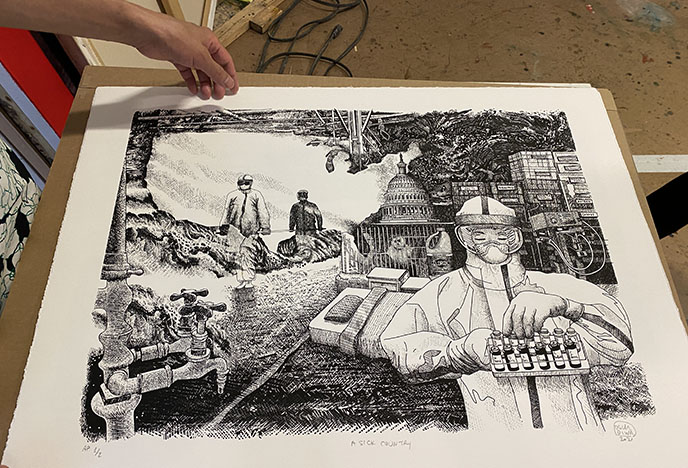
And I was delighted to visit artist Oscar Oiwa in his studio. Read on for an exclusive peek at his latest large-scale works, as well as his quarantine drawing series (detailing his experiences and musings in lockdown).

All things in life are fleeting, so take the time to see them while you can… Vessel NY is yet another example of this. Photographer Joey Wong and I managed to visit the honeycomb-metal structure days before it unexpected closed (possibly for good).
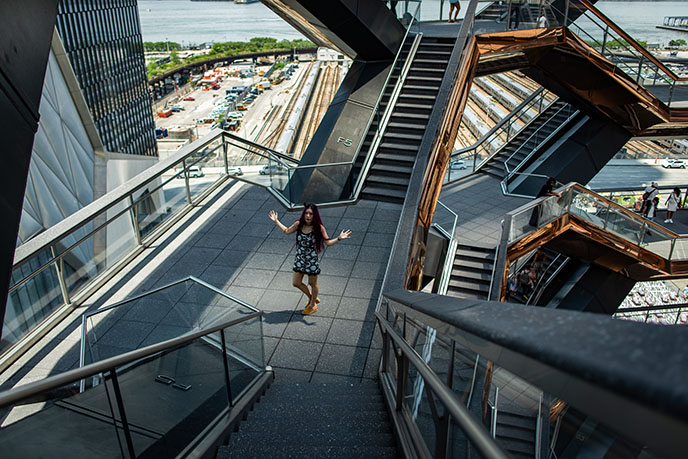
Located at Hudson Yards, Vessel is a geometric open-air structure that stands 16 stories high, and contains 2500 steps over 154 flights of stairs. I first went to Vessel in Feb 2019 but was keen to return, as the experience changes unexpectedly with the seasons and time of day.

Architect Thomas Heatherwick unveiled this gigantic sculpture / public installation in 2019. Vessel has garnered both praise and criticism for its Escher-esque design made from steel.

I personally think the concept is brilliant: it’s a joy to wander through the beehive, and take in the sunlit panes and patterns. (I’m wearing a celestial Gothic dress by Too Fast Clothing.)

Unfortunately, Vessel is closed for the foreseeable future due to tragedies that took place here…

The 360 degree design lets you take in views of the Hudson River and surrounding mid-town buildings, from all levels.

Vessel is a photographer’s dream — we had fun taking images from a variety of perspectives.

The view from the top is a dizzying one. A curved elevator runs up one side of Vessel, making it accessible (although it only stops on certain floors).
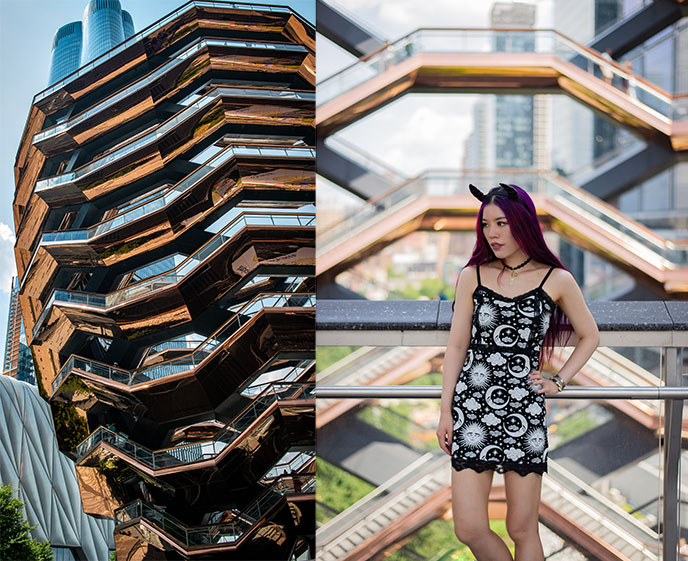
The fate of Vessel at Hudson Yards remains to be seen… (It is now closed, with no concrete plans to re-open).

After years of visiting and living in NYC, I finally got around to visiting the Noguchi Museum, located in the Long Island City section of Queens. The space is designed by the artist himself, Isamu Noguchi (1904–1988), to mirror his Zen-like artistic vision.

The Noguchi museum feels like a slice of Japan in NYC. The rock garden is particularly lovely: it contains a few of his abstract sculptures and a stone fountain, as well as transparent wind chimes that add a ghostly flutter to the greenery. (This was the sound installation Animitas by artist Christian Boltanski, which was on view at the time.)

Isamu Noguchi is a Japanese-American artist best known for his stone sculptures, which contain both rough and smooth panes, and are more complex than first meets the eye. This museum contains the largest collection of his works, which include architectural models and drawings.

Enter into the void…. Noguchi made this perfect circle from segments of marble. This modern sculpture references the ancient Japanese enso, or circular symbol of enlightenment.
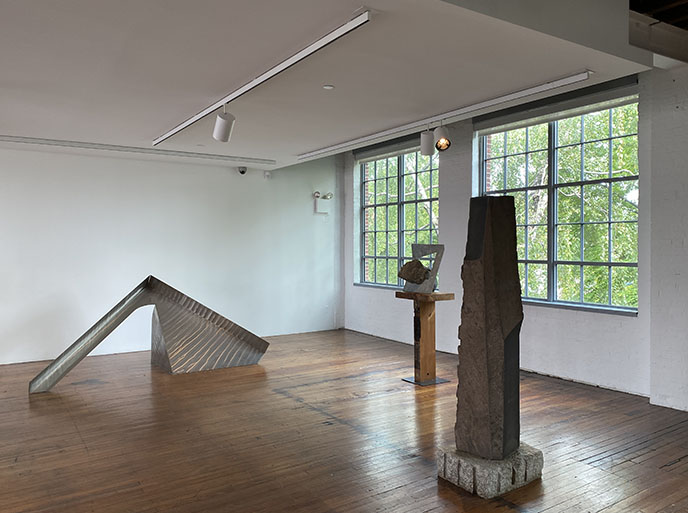
Noguchi is also known for his interlocking sculptures, and works made from wood and metal. I’m particularly fond of his mid-century interior designs, such as the stone-like Noguchi sofa and glass coffee table.

And I’ve long coveted a Noguchi lantern. In 1951, Isamu Noguchi visited the town of Gifu in Japan, and was inspired by the lanterns made by local artisans. Using natural materials, he created his own Akari range of lights in a variety of forms, which radiate peace and weightlessness.

As Noguchi put it, “All that you require to start a home are a room, a tatami, and Akari.” (And perhaps a metal cage or two?)

Many of Noguchi’s works have a touch of the surreal. Here are a few that juxtapose positive and negative space, and geometric and organic forms.

The top floor focused on Noguchi’s “Useless Architecture.” These designs served no specific function, but were merely for aesthetic purpose — like this step-terrace. The terrace is based on one of Noguchi’s models for an unrealized playscape (c. 1961–65) for Riverside Park in Manhattan.
Noguchi’s vision was inspired by the stairway to nowhere at Jantar Mantar, which I saw for myself when I was in India.
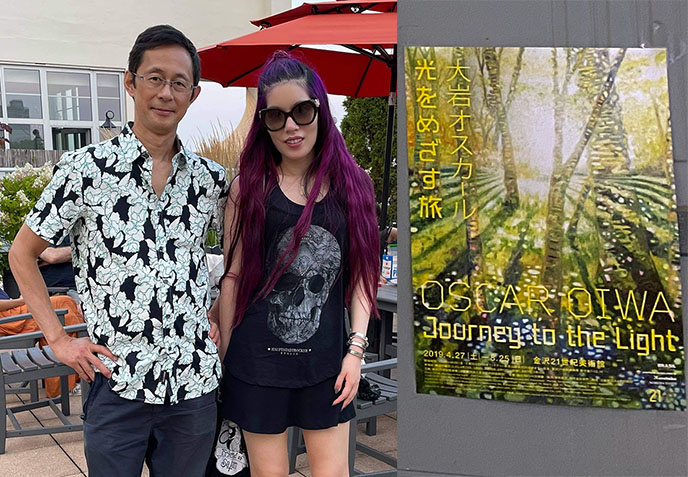
I also made a journey to the Queens studio of Oscar Oiwa (大岩オスカール)! When I was in São Paulo, Brazil, my friend Elizabeth Wurtzel and I saw his Paradise installation in an inflatable dome. We were mesmerised by his 360 degree swirling vortex of dark forests, pathways and skies. Since then, Oscar and I have been corresponding online.

At long last, I got to visit Oscar Oiwa’s studio, and get an inside look at his creative process. Oscar is a Brazilian-American-Japanese visual artist whose distinctive works have been exhibited worldwide.
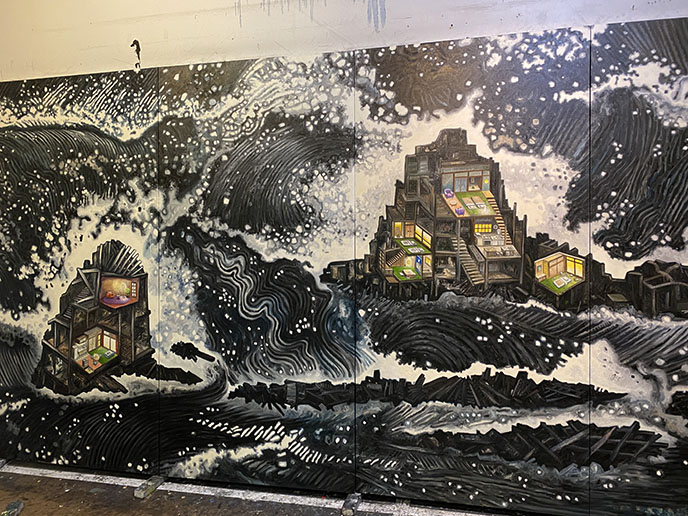
Oscar’s gigantic canvases feel like a portal to dream world. He details everyday scenes in these Japanese-style houses, which are tossed about by dark and mysterious waves.

During the pandemic, Oscar was confined to his apartment in NYC. The experience inspired him to create a series of drawings that reflected his thoughts and experiences. He describes them as “an imaginary trip in the midst of life under quarantine. The result is like a diary of insights about my past, my present daily life, and the future.”

Oscar’s quarantine art included depictions of an empty Times Square NY, and this surreal and whimsical portrait of Osaka’s Dotonbori food district. (He showcases the famous giant crab and fills a boat with takoyaki (octopus balls), the beloved street food.)

Oscar Oiwa is currently in Japan, where he is presenting a number of art exhibitions (details here). These include displays at the Tokyo Museum of Contemporary Art. Hopefully I can return to Japan sooner rather than later, to see his latest artworks for myself.
Until that day, you can look back at my Japan blog posts from over the years. You can also search my site (see Search box on the right sidebar) for specific topics or destinations. I hope you’ll find these resources useful as you plan your next trips abroad. And please keep in touch via @lacarmina social media, as I’ll be sharing my journey in Spain!
SHARE & COMMENT
Yayoi Kusama: Cosmic Nature at New York Botanical Garden! Japanese polka dots & pumpkins sculptures, Little Island NY.
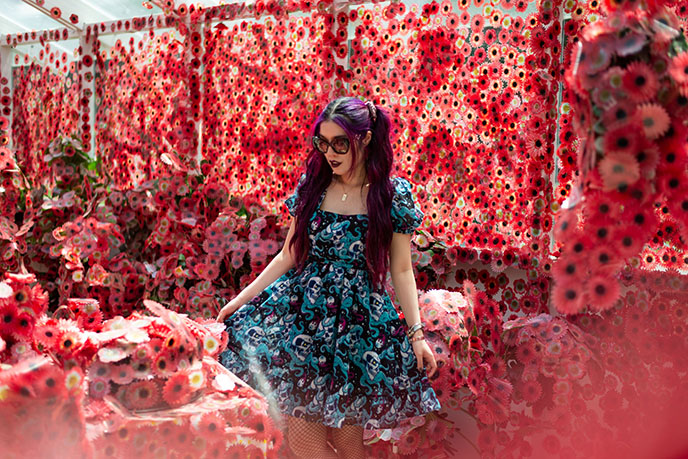
Dot, dot, dot! I love the zany Japanese contemporary artist Yayoi Kusama. During my NY trip, I got to see her giant pumpkins, and be part of her flower power obliteration room.
She currently has many eccentric installations on view at her Yayoi Kusama: Cosmic Nature show, at New York Botanical Garden in the Bronx.
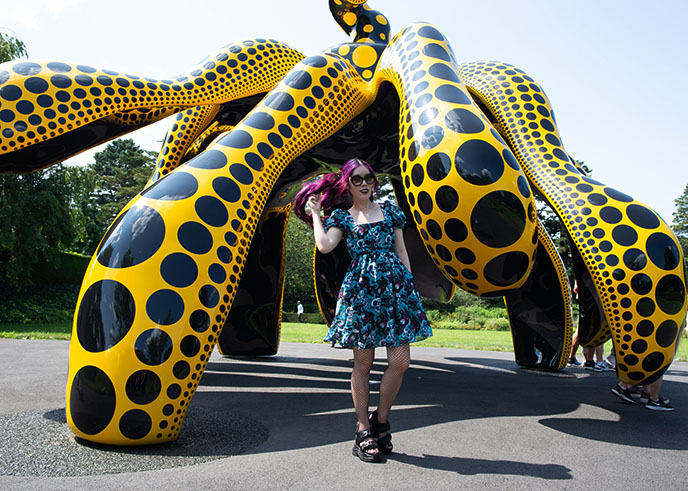
Yayoi Kusama’s exhibitions are found both indoors and outdoors, harmonizing with NYBG’s ponds and greenhouses. Strolling around, I felt like Alice in Wonderland as I encountered “Dancing Pumpkin” and her other incomparable works. (Kusama is known for her gourds, so it’s fitting that Cosmic Nature is open until Halloween – Oct 31, 2021.)
OOTD: Wearing a cream puff pirate print dress by Sourpuss Clothing.

New York Botanical Garden was founded in 1891. The living space has over a million plant species in a variety of environments, such as wetland and waterfall.
To get to the NYBG: From Manhattan, the most convenient route is via the Metro-North Railroad. Take the Metro-North Harlem local line from Grand Central Terminal to Botanical Garden Station; the ride takes 20 minutes. Then, walk across the street to the Mosholu Entrance, and you’re in.

Tickets to Yayoi Kusama’s Cosmic Nature are available in advance via their site. I encourage you to pick up a map when you enter, as it shows where her exhibits are located throughout the gardens. (I felt like I was on a treasure hunt, as I went from place to place.)
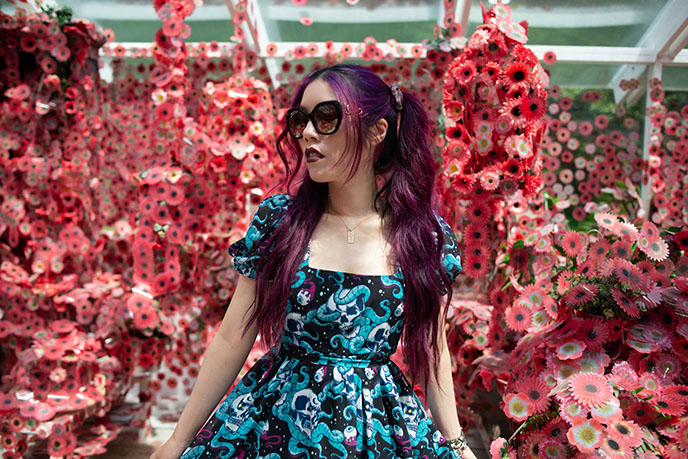
Yayoi Kusama has been fascinated with the natural world ever since her childhood in Japan. Much of her art is inspired by the patterns, shapes and colors of plants and flowers, which she pushes to the point of obliteration / infinity.
(All photos by Joey Wong.)
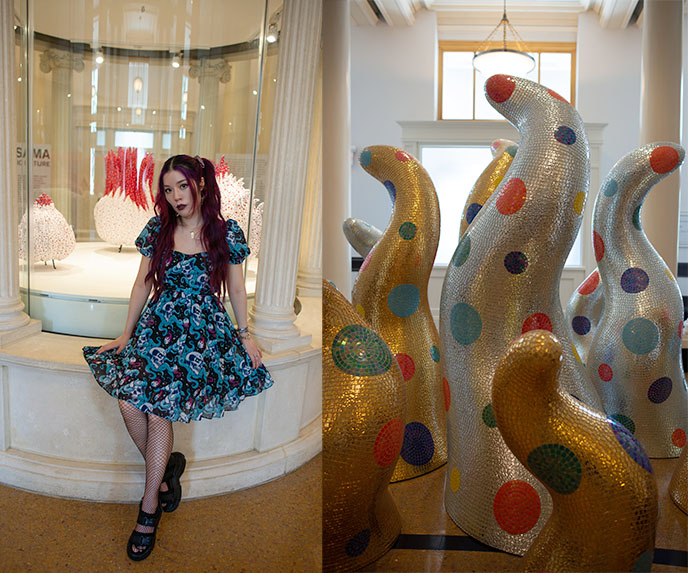
Yayoi Kusama has become a household name in the past decade. After her early years in Japan, she moved to New York City and created art that vibed with the swinging, happening subculture of the 1960s. (Mod tentacles, anyone?)
Later, the artist moved back to Japan to check into a mental hospital, where she continues to live and work… at age 92!

From the start of her career, Kusama’s works have been dotty (figuratively and literally). She experienced hallucinations since childhood, which made the world look like it was made of dots — and inspired her artistic vision.
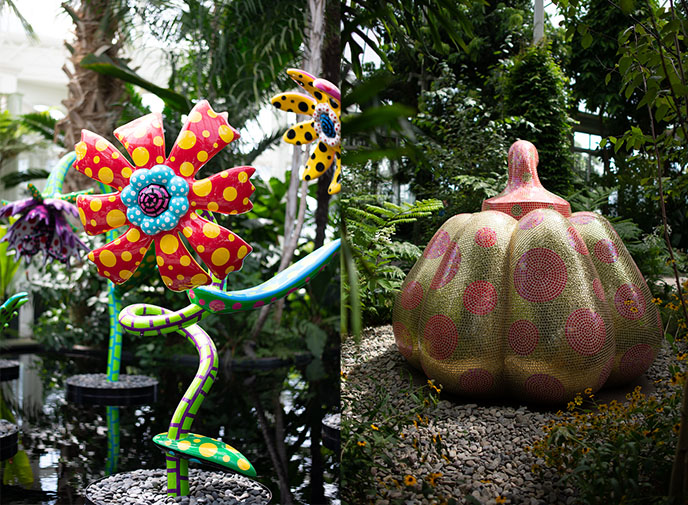
Her giant pumpkins, flowers, and other flora-based works get the polka-dot treatment. Love how they integrate with the natural surroundings at NYBG.
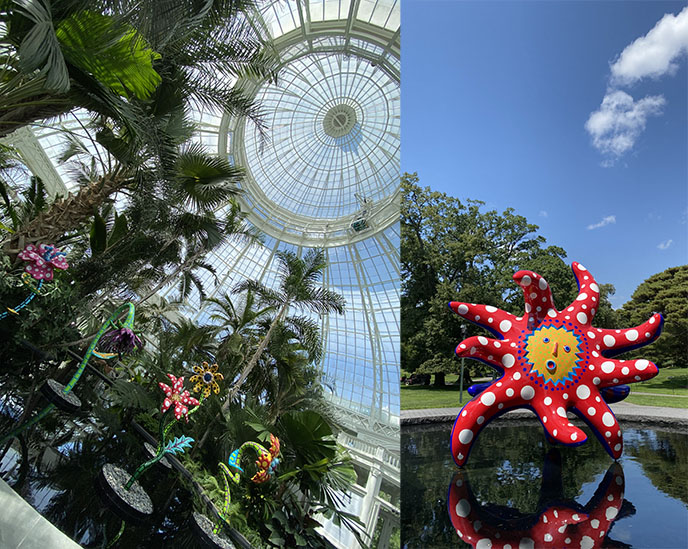
In “My Soul Blooms Forever” (left), her flowers stretch towards the glass dome of the Conservatory’s Palms of the World Gallery. On the right. “I Want to Fly to the Universe” seems to be reacting in surprise to its reflection in the pool!

My favorite spot was Yayoi Kusama’s first-ever obliteration greenhouse, “Flower Obsession.” Before entering, visitors receive a colorful red and black gerbera flower sticker.
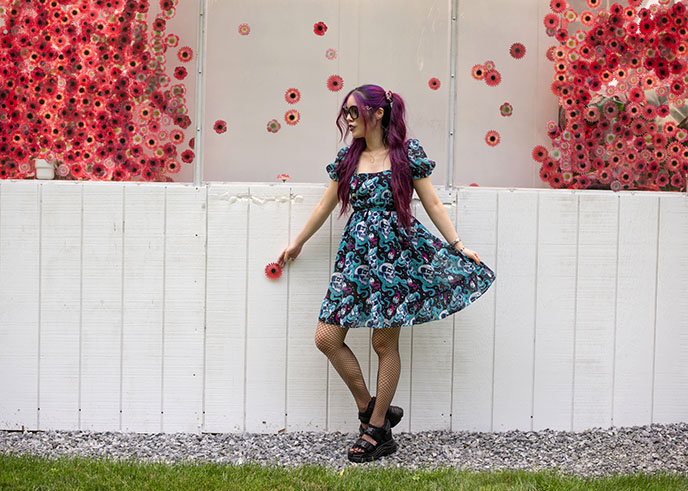
They must place the sticker somewhere in the interior — which lets them take part in an ever-changing Obliteration Room. (I didn’t realize that it was “dah-mee” to put my decal on the exterior of the greenhouse, until afterwards… oops!)

Visitors came up with clever ways to add their stickers to the Flower Obsession. Some created long chains of flowers, which hung down from the glass panel roofs.
My sunglasses are these by Roberto Cavalli: RC 1047 Chianciano oversize frames, with gold snakes on the arms.
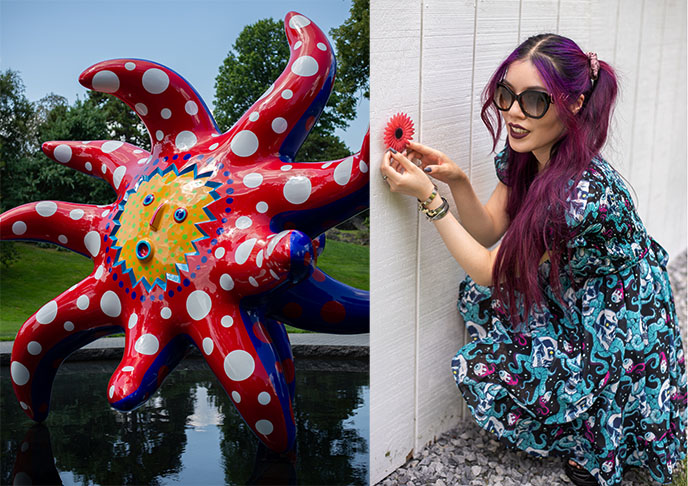
I suppose the NYBG caretakers will make a “Pikachu surprised face” much like this starfish-y sculpture, when they find my sticker here!

Yayoi’s Flower Obsession edges further towards obliteration over time, as more people add stickers to the furniture and walls.
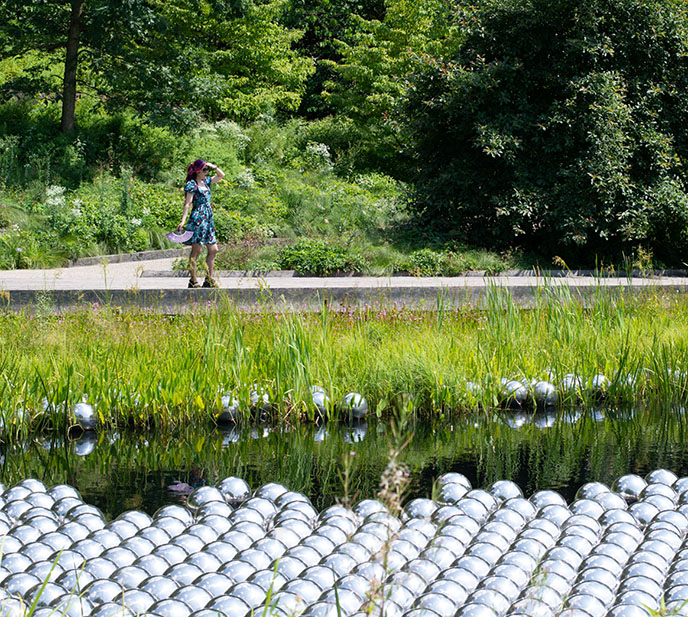
Be sure to visit Yayoi’s “Narcissus Garden” at New York’s botanical garden — a disruptive art piece that she introduced at Venice Biennale in 1966.
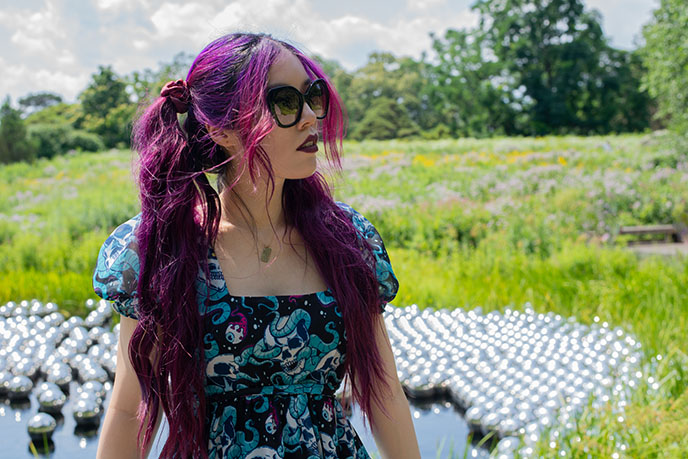
The shiny steel orbs float on the shallow pond of the Native Plant Garden. The wind changes the arrangement of the silver balls, and brings about a gentle melody as they clink together.
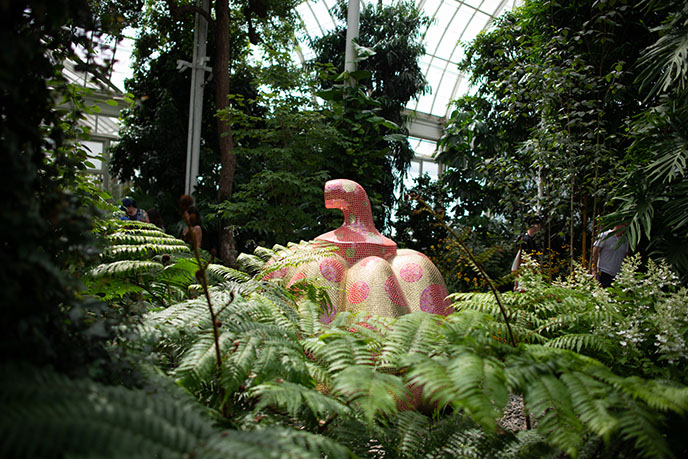
With a glittering orange skin, Yayoi’s “Starry Pumpkin” looks like magic among the ferns.

Yayoi Kusama: Cosmic Nature had a few areas that prohibited photography — so you’ll have to come for yourself to see these areas. They include collections of her early canvases, and an Infinity Mirrored Room. Walk into a dark space, and you’ll find lit-up and dotted gourds reflected endlessly through mirrors (“Pumpkins Screaming About Love Beyond Infinity”).
My tentacles dress by Sourpuss Clothing matches the phallic theme in many of her works.
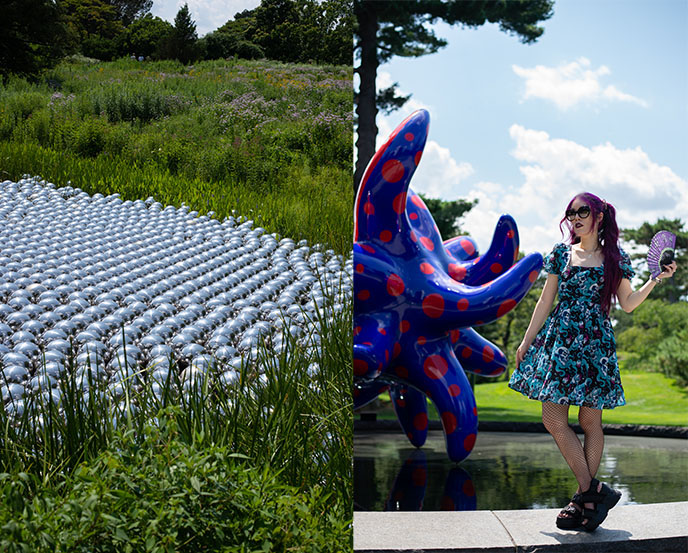
Loved seeing Yayoi Kusama’s vision in the context of a gorgeous garden. Here’s another view of “Narcissus Garden” at the pond, and the back side of “I Want to Fly to the Universe.”

Even a path through the trees gets the Yayoi treatment. The artist wrapped branches and trunks in red and white fabric, for “Ascension of Polka Dots on the Trees.”
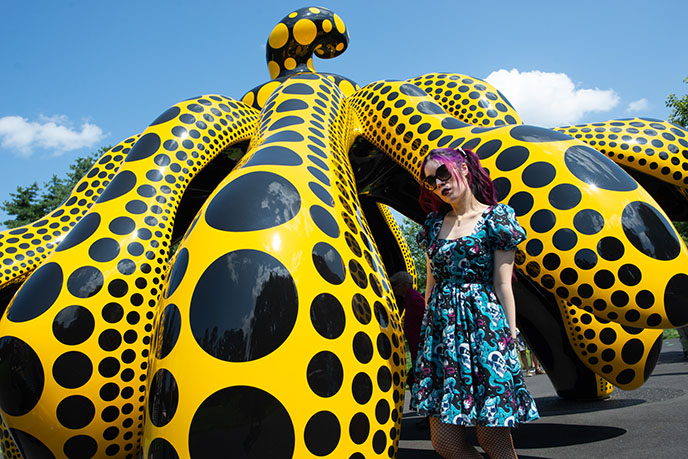
The gardens are able to hold her largest-scale works, such as “Dancing Pumpkin.” (Why choose between tentacles and pumpkins, when you can have both?). So much fun walking around and through her giant yellow-and-black-dotted bronze sculpture.

Yayoi Kusama’s works have added impact in the botanical landscape. Most of the art can also be experienced outdoors and without lineups, making Cosmic Nature a perfect outing for our time of social distancing.

This isn’t my first encounter with the Japanese artist. I saw also saw Yayoi Kusama’s show in Stockholm; see the review here (my hair was much shorter with an undercut at the time!). And I went to Naoshima Island in Japan, where I considered moving into one of her pumpkin houses.
I hope you’ll get a chance to see Yayoi Kusama: Cosmic Nature at NY Botanical Garden… before we all turn into pumpkins on Halloween.

NYC always lets me scratch my itch for culture and architecture. On my recent trip, I also checked out the new Little Island at Pier 55. (Tickets are free, but you must make advance timed bookings.)

The Hudson River Park area continues to be revitalized, this time with three acres of green space floating on a bed of “tulip” stilts. On Little Island, you can enjoy views of mid-town Manhattan, and experience art and music by locals.

These 132 pot-shaped “tulips” suspend Little Island above the water, much like a floating leaf.

Little Island’s park has a variety of topologies — go up the twisting wood stairs to discover gardens, performance spaces, food trucks, interactive op art, and more. I encourage you to visit if you’re in New York City.

And a thank you to True Travel Podcast for interviewing me about alternative travel and fashion journalism, Japan, blogging / social media and more.
I also was a guest on We Travel There travel podcast. We discuss my favorite places in Osaka, Japan, including a 666 boutique.

Wishing you a happy Halloween, with an emo-hipster outfit snap. Special shout-out to everyone who’s been reading this blog since the MySpace days… Thanks for being with me throughout all of life’s changes!
 LA CARMINA
LA CARMINA






